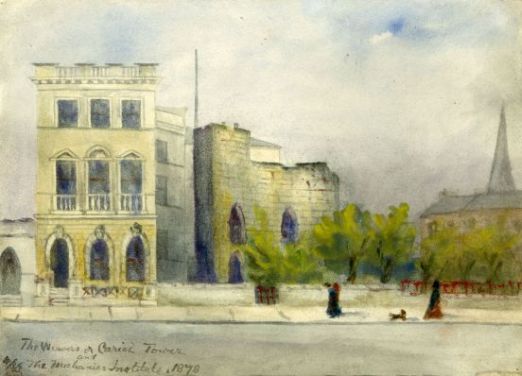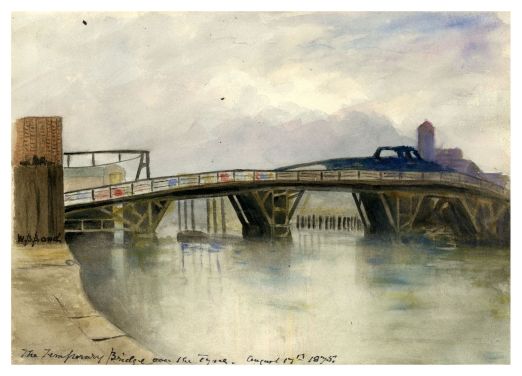
(Newcastle-upon-Tyne: Andrew Reid; London: Elliot Stock, 1890)
(Rare Books Collection, RB 942.82 BOY Quarto)
In 1769 James Granger’s Biographical History of England was published with deliberately blank pages for the purchaser to customise. Thus grangerised entered rare books terminology. Extra-illustrated is a more user-friendly term which has come to be commonly used today. Typically, book owners have customised copies by adding engraved portraits and topographical prints but sometimes autograph letters, drawings, watercolours and other documents have been pasted in and this is exactly what W.B. Bond has done with his copy of J.R. Boyle’s Vestiges of old Newcastle and Gateshead (1890).
The publication is not as scarce as some other titles held in the Philip Robinson Library’s Special Collections: twelve other institutions are listed on COPAC as holding copies, from the National Library of Scotland, to the British Library and Trinity College Dublin. What make our copy unique are the two hundred and thirty engravings, watercolours and autographs which have been added. These include: autograph letters from historians and antiquaries John Hodgson, John Collingwood Bruce, W.H. Longstaffe, and Richard Welford; engraved portraits of King Charles II and Oliver Cromwell; a bookplate taken from a copy of Il Decamerone (1727), the title page of which had borne the inscription of musician Charles Avison; engravings of local views and landmarks, such as Alnwick Castle, Sunderland harbour, and Jesmond cemetery; and original watercolours depicting the Holy Jesus Hospital, an old house in Low Friar Street, almshouses in Westgate Street, Thomas Bewick’s workshop at St. Nicholas’ church yard, and more.
Two local watercolours have been chosen to illustrate this ‘treasure’: The Weavers or Carliol Tower and The Mechanics Institute, 1878 and The Temporary Bridge over the Tyne – August 17th 1875, both signed by W.B. Bond.
The Weavers or Carliol Tower and The Mechanics Institute, 1878 (above):
Newcastle was fortified in the Thirteenth Century and Carliol Tower, named after the De Carleiol family, was one of the seventeen towers which were features of the town wall. The discovery, by workmen in 1824, of a cannonball is evidence that it came under fire when the Scots stormed Newcastle in 1644. Less than twenty years after the violence of the English Revolution, or Civil War, the Weaver’s Company appropriated the tower as a meeting house. The tower was repaired and enlarged in 1821 but, like many of the town’s defensive towers, was demolished in the late Nineteenth Century. The foundation stone for The Mechanic’s Institute which adjoined Carliol Tower, on New Bridge Street, had been laid on 19th April, 1865. From 1866, it housed a library and was a venue for lectures on industrial developments and for delivering engineering classes. In 1880, The Mechanics’ Institute became part of the new City Library.
The Temporary Bridge over the Tyne – August 17th 1875 (below):
Bond has not specified the location of this temporary bridge over the Tyne. However, a temporary bridge existed whilst the Swing Bridge was being constructed and it is possible that this is what Bond painted, looking across the river towards Gateshead and St. Mary’s Church. The Roman Pons Aelius had first spanned the Tyne but it had been replaced by a mediaeval stone bridge. When this was destroyed by the flood of 1771, a new stone bridge was built in its place. Increased shipping resulted in that bridge being removed in 1866 and it wasn’t until 1876 that the Swing Bridge was opened. Thus, it is possible that the watercolour depicts the temporary wooden bridge at time when it had almost run the course of its usefulness and with the construction of the Swing Bridge glimpsed immediately behind it.
According to a manuscript annotation on a front endpaper, Bond inserted the additional engravings, watercolours and autographs whilst in San Sebastiano, Venice, 1913 and two items which had been addressed to him there are tipped in at the end of the second volume.

(Newcastle-upon-Tyne: Andrew Reid; London: Elliot Stock, 1890)
(Rare Books Collection, RB 942.82 BOY Quarto)
